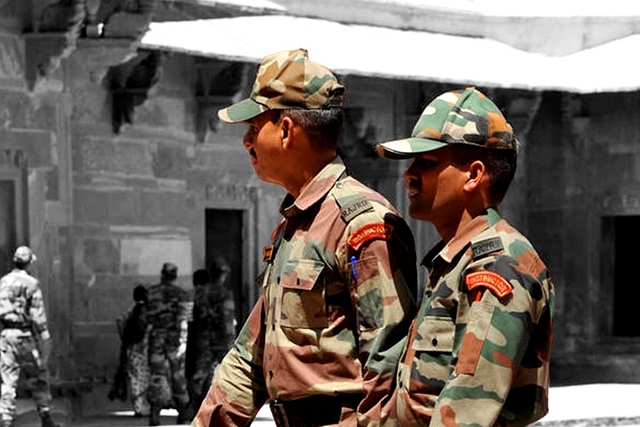
This Is Why Indian Army Wants State Police And Central Forces To Stop Donning Copycat Camouflage Uniforms
The combat uniforms donned by army, police and CAPF personnel look the same to the common man, and the army wants to restrict its use.
The Indian Army had requested the government to disallow state police and central armed police forces (CAPF) like the Border Security Force (BSF), Central Reserve Police Force (CRPF) and Central Industrial Security Force (CISF) from wearing army-style combat uniforms.
The request, made many times in the past, comes in the wake of reports and rumours that the army had been deployed in trouble-torn parts of Delhi in the last few days.
The people, and the media, saw policemen in army-style ‘disruptive pattern’ combat uniforms and mistook them for the army, thus leading to the mistaken notion about army deployment.
But there is, as the army rightly maintains, absolutely no logic in policemen donning combat uniforms.
The ‘disruptive pattern’ combat uniforms that have been developed by the Defence Research and Development Organisation (DRDO), is meant to camouflage a soldier in a combat situation.
“In an urban area, there is no need for a policeman to conceal his presence. So why wear a combat uniform that looks like the army’s?
“Conversely, while patrolling a trouble spot or at a crime scene, the police needs to make its presence felt. So wearing a combat uniform whose primary purpose is to camouflage the wearer from an adversary makes no sense,” pointed out a Major General-ranked army officer at the Eastern Command headquarters in Kolkata.
Army officers concede that it makes sense for police to don the combat uniforms only while undertaking anti-insurgency or anti-Maoist operations that would require them to conceal or camouflage their presence.
Even the BSF and the Indo-Tibetan Border Police (ITBP), which man the Indo-Bangladeshi and Indo-Tibetan borders respectively, do not need to wear combat uniforms, say army officers.
“They (the BSF and ITBP) man static posts and patrol the international borders. They need to be seen at their posts and on their patrols both by the forces on the other sides of the borders and criminals who may be attempting to breach the borders. So it makes no sense for them to wear camouflage uniforms whose primary purpose is to conceal the presence of the wearer,” said the officer.
“The misuse of the ‘disruptive pattern’ combat uniform has gone to such ridiculous lengths that even CISF personnel at airports wear such uniforms. Who do they need to conceal themselves from while frisking people or examining baggage?” wondered another army officer.
Special Task Force (STF) personnel of many state police forces and policemen who have undergone ‘commando’ training and posted in specialised units also wear camouflage uniforms when they don’t need such uniforms at all.
But police officers contend there is a reason for police personnel deployed in patrolling duties at trouble spots or even in maintaining law and order donning combat uniforms.
“That (army-lookalike) camouflage uniform inspires awe and even fear, and is a big deterrent for troublemakers. Even a policeman wearing that combat uniform feels more empowered and confident,” said a joint commissioner of Kolkata Police who did not want to be named.
What the officer unwittingly admitted is that the ‘khaki’ uniform no longer inspires any confidence and respect of the law-abiding citizenry or fear among the lawbreakers. And that is why policemen need to don army-style camouflage uniforms.
The ‘khaki’ uniform of the police has become such a sad symbol of avarice, corruption, exploitation and inefficiency that it fails to evoke any respect anymore. “The police themselves are responsible for this degeneration,” said the army officer.
But, warn army officers, policemen wearing combat uniforms over a prolonged period has the inherent danger of lowering the prestige of this uniform.
“To the common man, the combat uniform of the soldier signifies a lot of prestige and commands a lot of respect. That can get eroded if the police or CAPF personnel keep on wearing combat uniforms while engaged in civilian duties,” warned the army officer.
During the 2016 Jat agitation in Haryana, army columns deployed to stage flag marches and patrol riot-affected areas had to hold placards proclaiming ‘Army’.
That was because, explained a retired two-star general who was posted at the army headquarters at that time, the rioters and troublemakers initially mistook army personnel for policemen and CAPF personnel.
“The army’s presence initially evoked no fear among them and they continued to create trouble thinking the army personnel were policemen who would remain inactive. Our men had to warn them that they were the army and would brook no trouble. Only after the civilian population realised that the men in combat uniforms were army personnel did things calm down,” said the retired officer.
The army has now written to the Department of Military Affairs (DMA) under the Chief of Defence Staff (CDS) requesting that the Ministries of Defence and Home Affairs issue clear guidelines to state police forces and CAPF engaged in law and order duties and deployed in urban areas to stop wearing combat uniforms.
The army has opined that police and CAPF personnel may be allowed to wear combat uniforms only when deployed in jungle terrain for special operations and in Maoist-affected areas. Even the bullet proof jackets worn by police and CAPF personnel should be of plain khaki colour.
Disruptive pattern camouflage combat uniforms were introduced in the Indian Army when its units were deployed as Indian Peace Keeping Force in Sri Lanka.
After state police and CAPF personnel started copying the uniform, the then army chief General J J Singh in 2005 introduced a ‘watermark’ on the uniform with the army emblem (of crossed swords) and the words ‘Indian Army’ embossed on them to distinguish between soldiers and cops wearing similar uniforms.
But the combat uniforms donned by army, police and CAPF personnel look the same to the common man. Hence, the army wants to restrict its use.